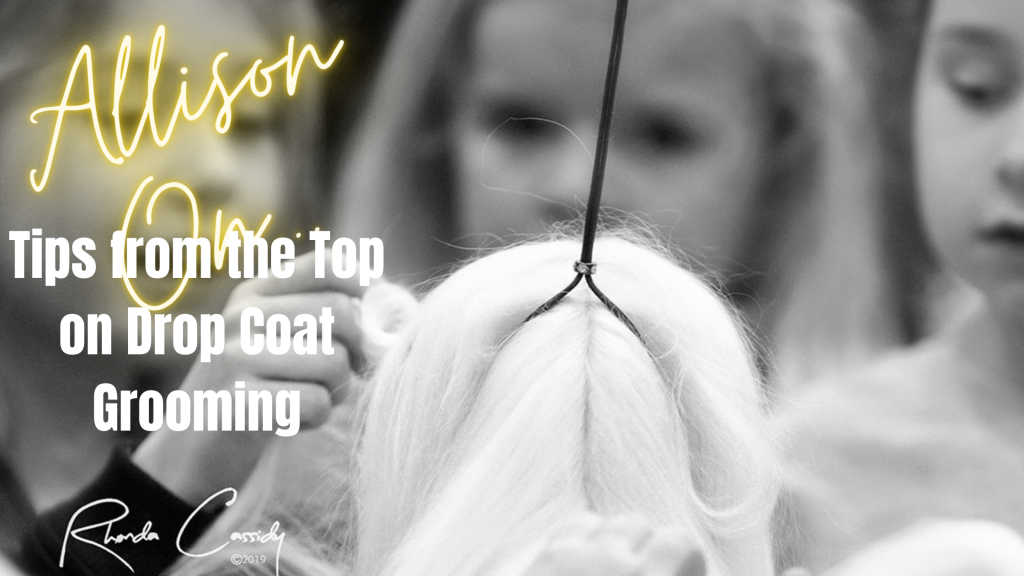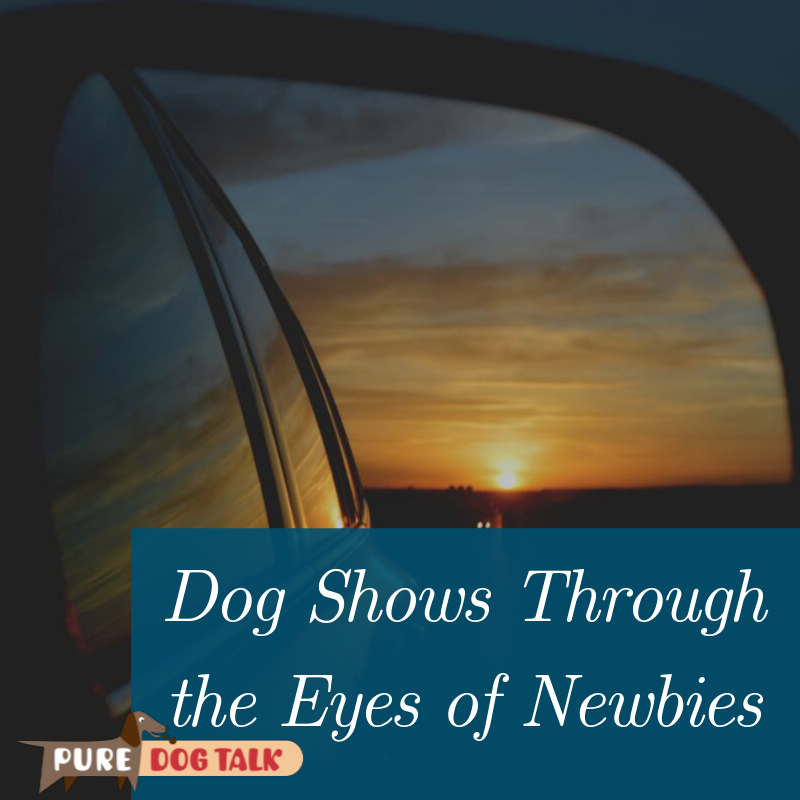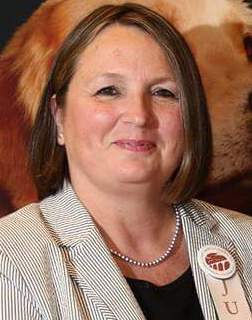465 – Allison On: Tips from the Top on Drop Coat Grooming
Allison On: Tips from the Top on Drop Coat Grooming
Allison Alexander, founder of Leading Edge Dog Show Academy and President of the Canadian Professional Handlers Association, joins host Laura Reeves to talk about grooming drop coated breeds, from maintenance to polish.
Allison’s years of experience provide enormous insight into the maintenance on coated breeds from a Maltese to a Briard. Along with professional tips on the tools of the trade…. What kind of pin brush, what type of wraps, HOW to wrap and band. We cover it all right here. Read on for just the tip of the iceberg. And click to listen to the entire fabulous conversation.
“Obviously the basics start with line brushing,” Allison said. “And one thing I will say about drop coats, and people might disagree with me, but drop coats more than any other coat type, you can’t have a bad day.
“Even a poodle in full show coat, you can skip a bath. They could get wet in a rainstorm or snowstorm and it’s midnight and you’ve driven for two days to get home and, I’m not recommending it, but you can let them get away with like towel him dry, sleeping it off overnight and starting the next day. You have a long coat, especially as single-coated long coat, and you do not have those options.
“So the commitment is like times 10 to me. There are no days off. So when it comes to line brushing to me to keep a really fully coated drop coat breed in coat, line brushing has to be something that you’re doing every day. You’re going to change those wraps every day. You’re going to change that topknot every day. You’re going to make sure that they look perfect.
“When it comes to line brushing, my kind of general rule of thumb is, the longer the coat the more coat they have, the longer the pin in the pin brush. When it comes to a single-coated drop coat, I’m going to use a brush with a slightly softer pad firmness. The double-coated drop coats, I’m going to use a brush that has a slightly firmer pad that the pins go in.
“We also know that no matter what we’re brushing, but again more important for long coats, never, ever brush the coat dry. You need some kind of brushing spray, whether it’s a brushing spray that’s just cutting down on static, whether it’s one that’s adding some kind of conditioner to the coat or whether it’s a detangling brushing spray. But they cannot be brushed dry. You’ll just keep snapping those ends off.
“When I am line brushing, I like to teach my dog to lay down on their side. Especially a drop coat because obviously, with that longer outer coat hanging down, you’re not going to get underneath. So if you’re drop coated dog is standing up, even if it’s a Skye terrier, even if it’s a Briard, how are you going to hold all of that coat up out of your way. You’re not going to be able to do that. So the first thing you can do is teach your dog to lay down on the table.
“Remember that our grooming tables are fabulous, they have non slip surfaces, but they are not the thing that our dog really wants to lay on. When I’m laying my dogs down to be line brushed, they typically have maybe a yoga mat, a grooming mat or like a thin dog bed, at the very least a nice thick bath towel underneath them. Mine typically have some kind of grooming mat and then a nice thick bath towel underneath them so that they’re comfortable. ‘Cause you’re going to be here for awhile.
“You’re going to start at the very shortest hair like as far down on the belly as you can and then I like to take the sections when I’m line brushing… so line brushing actually means going line by line through the coat… you have to create those lines. So, you’re creating those lines, typically you could use a knitting needle. I like to use a plastic rat tail comb. Some people use a metal rat tail comb, some people get really good at using their fingers.
“I like to go about a finger width between each line ’cause sometimes people are lined brushing but they’re using like 3 inches of code at a time and wondering why they’re not getting the same results so a fingers width. Obviously like on a little dog like a Maltese it probably would be my little finger and probably on a bigger dog like a Skye terrier, a Briard, it would be like a bigger finger.
“You’re going to take a layer coat, you’re going to mist it with whatever your brushing spray is, brush it with your pin brush, check it with your comb. We’re not using our comb to groom the dog because otherwise you’re going to be removing too much coat. We’re using the comb to check that we did get all the way down to the skin from one end of that line that we did (to the other.)
“Typically I’m going to go from the belly to the top line. Then I’m going to do each leg in the same manner. I don’t typically do the legs or the tail or the neck at the same time. I go from the armpit to the loin area all the way up from the belly. Then I’m going to the front leg from the bottom of the foot up. Back leg, under the tail, the tail, then the neck. It’s in sections. An it’s line by line by line.”
314 – Dog Shows Through the Eyes of Newbies
Dog Shows Through the Eyes of Newbies
I was honored to visit with four brand “newbies” recently in a panel discussion format. These folks shared truly valuable information about what got them started, what they love and even what they don’t.
Huge thanks to listener Dr. Clifton Jamil Kenon Jr whose idea this was. The announcement on PureDogTalk’s FB page garnered 147 comments from folks who were so excited to share their experiences. I hope to make a continuing series of these types of conversations because the stories I received were so amazing.
Kenon, Kristin Eberly, Neil Trilokekar and Kayla Croteau represent a wide spectrum of the dog fancy. They share their fascinating journeys into the sport of purebred dogs, talk about mentors, what they love and what has been frustrating in each of their individual experiences.
Mentorship
“Meet people where they are,” Kenon advises mentors and would be mentors. “Everyone comes to the table with their own goals. This is a sport that lends itself to diversity.” Kenon’s mentor, Susan Giles, visited with me on the podcast just recently.
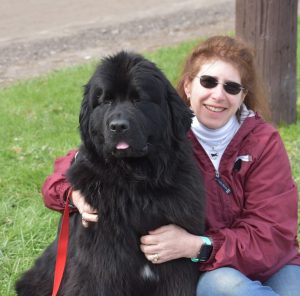
Kristin Eberly
The best help Eberly found is from her handling class instructor, who she says offers “criticism wrapped in something positive.”
Trilokekar said his mentors have encouraged him to study and think critically. “They share their knowledge without expecting me to be obedient,” he noted.
Croteau said her mentor is always open to the silliest of questions and is always positive.
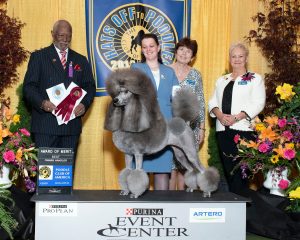
Kayla Croteau
Strongest encouragement
- “Set your own goals,” Kenon said. “Celebrate the wonderful people who help you get there. Ignore the people who want sink everybody’s ship. Don’t go broke doing it. Have fun.”
- “Don’t be afraid to ask for help,” Eberly offered. “Long time people in the breed can be intimidating. Those people will help you if you just ask.”
-
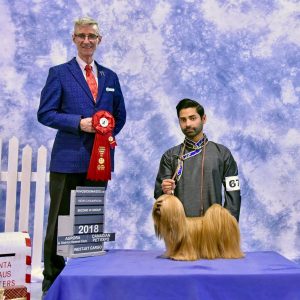
Neil Trilokekar
“Find your fascination,” Trilokekar encouraged. “So many facets you can be engaged by. Learn about history, and heritage of your breed. Go do other things with people when you’re at a dog show. Build a relationship. Never stop learning.”
- “Coming in it was pretty terrifying,” Croteau opined. “Remember we’re all here because we love the dogs. Set small goals. Don’t just come to the show, show and go home. Hang out. Have an open mind and big ears.”
272 – Pam Bruce: Memories and the Essence of Style in Purebred Dogs
Pam Bruce: Memories and the Essence of Style in Purebred Dogs

Pam Bruce and Michael Canalizo get groovy at Woofstock.
Pam Bruce, fourth generation Canadian dog fancier, joins host Laura Reeves in part one of a wide-ranging very personal interview on history, people, judging, breeding and the essence of “style” in purebred dogs.
The quintessential dog person, Bruce shares stories and humor and insight reminiscing about the legends of the sport – Michelle Billings, Jane Forsyth, Anne Rogers Clark, Michael Canalizo, Ginny Lyne, Dick Meen and many more.
Bruce finished her first dog, a Maltese, at four years old. Her family owned Maltese and later Lhasas. Perhaps best known for her association with Canalizo and the Grandeur Afghans, Bruce breeds Airedales today.
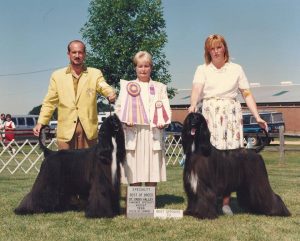
Bruce and Canalizo in competition with Ch. Tryst of Grandeur and Ch. Yours Truly of Grandeur.
Allowed to Brush
In a lifetime of “doing hair,” both brushing and hand stripping, she finds that the two coat types develop balance. “You brush away and pull towards, so the actions balance each other out.”
Steeped in the tradition of learning from the ground up, Bruce talks about the tasks that she was “allowed” to do as a young girl. Generational standing gave her no “out” on the grunt work. Being trusted with tasks like cleaning pens and brushing dogs was an “earned” privilege.
Being the first person at the dog show was a badge of honor, Bruce noted. Describing her work day as an assistant with one particular handler, she would have all toy dogs bathed before 8 am, dry them in order of their ring time and then work through the bath and blowout of the poodles, Afghan and Lhasa.
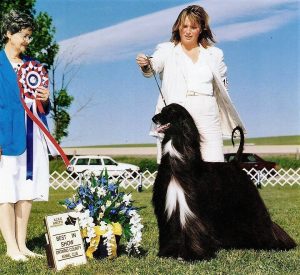
Pam Bruce showing Ch. Yours Truly of Grandeur to Best in Show.
Bruce describes the origin of her understanding of focus, being meticulous, and taking care of the dogs first.
“One thing I learned,” Bruce said. “I don’t remember a bad word being said about anyone or their dogs. Everybody has a talent and something to bring to the table. You should never ever speak of anyone poorly because together we make up what is this passion for all of us, which is this sport.”
Teamwork to keep breeding dogs
As one of the few remaining active connections to the days of big kennels, Bruce continues to emphasize dog shows as an evaluation of breeding stock.
“Those big working kennels had numbers,” Bruce said, “but that afforded us the ability to learn the quality (of the dogs).”

Pam Bruce with her homebred Airedale.
Lacking those facilities in today’s society, Bruce said teamwork picks up the slack. Sharing in a network of other Airedale breeders, “I can go back to the people working with me and get what I need.”
“Breeding is about the artform, the intrinsic qualities of the breeds,” Bruce said. “The best indicator of what you’re going to get is what you’ve had. Quality begets quality. You need to have foresight. I’m always breeding three generations ahead.”

